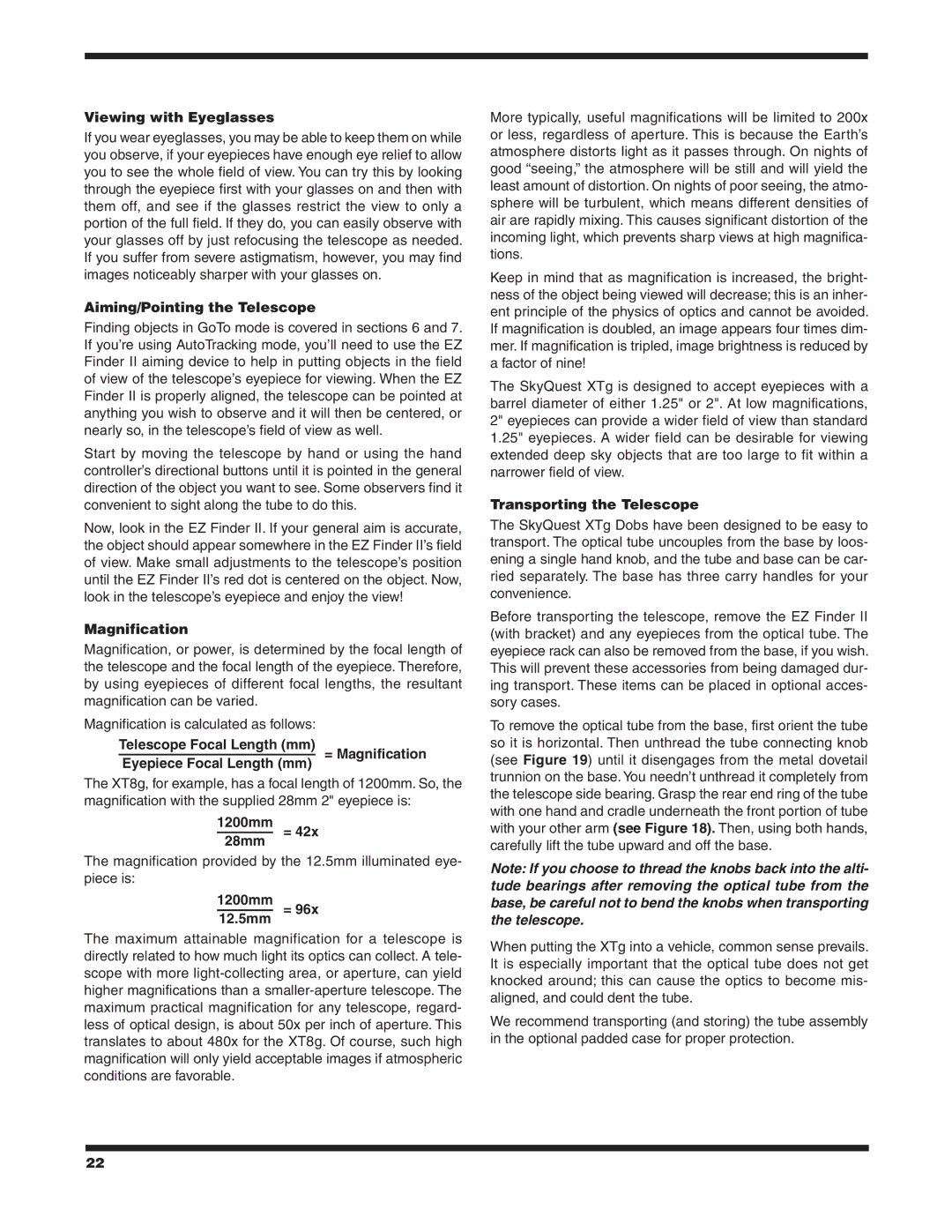Viewing with Eyeglasses
If you wear eyeglasses, you may be able to keep them on while you observe, if your eyepieces have enough eye relief to allow you to see the whole field of view. You can try this by looking through the eyepiece first with your glasses on and then with them off, and see if the glasses restrict the view to only a portion of the full field. If they do, you can easily observe with your glasses off by just refocusing the telescope as needed. If you suffer from severe astigmatism, however, you may find images noticeably sharper with your glasses on.
Aiming/Pointing the Telescope
Finding objects in GoTo mode is covered in sections 6 and 7. If you’re using AutoTracking mode, you’ll need to use the EZ Finder II aiming device to help in putting objects in the field of view of the telescope’s eyepiece for viewing. When the EZ Finder II is properly aligned, the telescope can be pointed at anything you wish to observe and it will then be centered, or nearly so, in the telescope’s field of view as well.
Start by moving the telescope by hand or using the hand controller’s directional buttons until it is pointed in the general direction of the object you want to see. Some observers find it convenient to sight along the tube to do this.
Now, look in the EZ Finder II. If your general aim is accurate, the object should appear somewhere in the EZ Finder II’s field of view. Make small adjustments to the telescope’s position until the EZ Finder II’s red dot is centered on the object. Now, look in the telescope’s eyepiece and enjoy the view!
Magnification
Magnification, or power, is determined by the focal length of the telescope and the focal length of the eyepiece. Therefore, by using eyepieces of different focal lengths, the resultant magnification can be varied.
Magnification is calculated as follows:
Telescope Focal Length (mm) = Magnification
Eyepiece Focal Length (mm)
The XT8g, for example, has a focal length of 1200mm. So, the magnification with the supplied 28mm 2" eyepiece is:
1200mm = 42x 28mm
The magnification provided by the 12.5mm illuminated eye- piece is:
1200mm12.5mm = 96x
The maximum attainable magnification for a telescope is directly related to how much light its optics can collect. A tele- scope with more light-collecting area, or aperture, can yield higher magnifications than a smaller-aperture telescope. The maximum practical magnification for any telescope, regard- less of optical design, is about 50x per inch of aperture. This translates to about 480x for the XT8g. Of course, such high magnification will only yield acceptable images if atmospheric conditions are favorable.
More typically, useful magnifications will be limited to 200x or less, regardless of aperture. This is because the Earth’s atmosphere distorts light as it passes through. On nights of good “seeing,” the atmosphere will be still and will yield the least amount of distortion. On nights of poor seeing, the atmo- sphere will be turbulent, which means different densities of air are rapidly mixing. This causes significant distortion of the incoming light, which prevents sharp views at high magnifica- tions.
Keep in mind that as magnification is increased, the bright- ness of the object being viewed will decrease; this is an inher- ent principle of the physics of optics and cannot be avoided. If magnification is doubled, an image appears four times dim- mer. If magnification is tripled, image brightness is reduced by a factor of nine!
The SkyQuest XTg is designed to accept eyepieces with a barrel diameter of either 1.25" or 2". At low magnifications, 2" eyepieces can provide a wider field of view than standard 1.25" eyepieces. A wider field can be desirable for viewing extended deep sky objects that are too large to fit within a narrower field of view.
Transporting the Telescope
The SkyQuest XTg Dobs have been designed to be easy to transport. The optical tube uncouples from the base by loos- ening a single hand knob, and the tube and base can be car- ried separately. The base has three carry handles for your convenience.
Before transporting the telescope, remove the EZ Finder II (with bracket) and any eyepieces from the optical tube. The eyepiece rack can also be removed from the base, if you wish. This will prevent these accessories from being damaged dur- ing transport. These items can be placed in optional acces- sory cases.
To remove the optical tube from the base, first orient the tube so it is horizontal. Then unthread the tube connecting knob (see Figure 19) until it disengages from the metal dovetail trunnion on the base. You needn’t unthread it completely from the telescope side bearing. Grasp the rear end ring of the tube with one hand and cradle underneath the front portion of tube with your other arm (see Figure 18). Then, using both hands, carefully lift the tube upward and off the base.
Note: If you choose to thread the knobs back into the alti- tude bearings after removing the optical tube from the base, be careful not to bend the knobs when transporting the telescope.
When putting the XTg into a vehicle, common sense prevails. It is especially important that the optical tube does not get knocked around; this can cause the optics to become mis- aligned, and could dent the tube.
We recommend transporting (and storing) the tube assembly in the optional padded case for proper protection.

